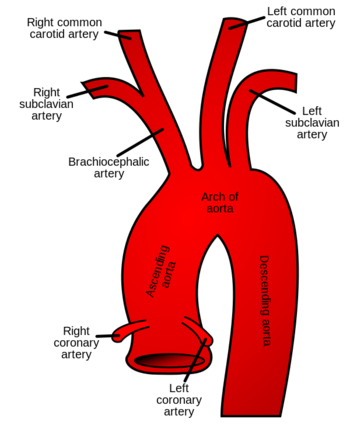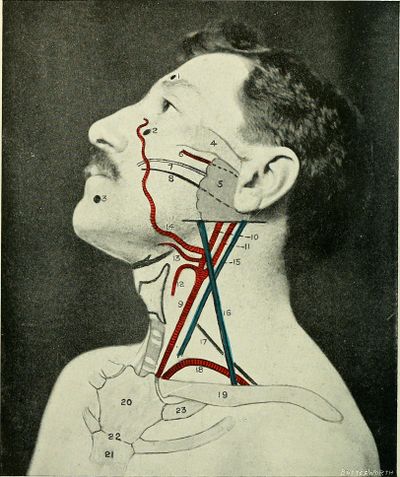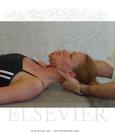Common Carotid Artery: Difference between revisions
No edit summary |
Kim Jackson (talk | contribs) m (Text replacement - "[[Cervical Arterial Dysfunction|" to "[[Vascular Pathologies of the Neck|") |
||
| (44 intermediate revisions by 5 users not shown) | |||
| Line 1: | Line 1: | ||
= | <div class="editorbox"> | ||
'''Original Editor ''' - [[User:Asma Alshehri|Asma Alshehri]] | |||
'''Top Contributors''' - {{Special:Contributors/{{FULLPAGENAME}}}} | |||
</div> | |||
== Description == | |||
[[File:Comon_carotid.png|right|frameless|433x433px]] | |||
[[File:Carotid artery.jpg|right|frameless|477x477px]] | |||
The Common Carotid artery is a large elastic artery which provides the main blood supply to the head and neck. The carotid arteries are the primary vessels supplying blood to the brain and face. | |||
The right common carotid artery (RCCA) originates in the neck from the brachiocephalic artery | |||
The left common carotid artery (LCCA) arises in the thorax from the arch of the aorta. | |||
= | Both right and left common carotid arteries bifurcate in the neck at the level of the carotid sinus into the internal carotid artery (ICA), which supplies the brain, and the external carotid artery (ECA), which supplies the neck and face.<ref name=":0">Sethi D, Gofur EM, Waheed A. [https://www.ncbi.nlm.nih.gov/books/NBK545238/ Anatomy, Head and Neck, Carotid Arteries]. InStatPearls [Internet] 2019 Jul 22. StatPearls Publishing. Available from:https://www.ncbi.nlm.nih.gov/books/NBK545238/ (last accessed 27.5.2020)</ref> | ||
= | == Course == | ||
= | The carotid arteries originate posterior to the sternoclavicular joints and in the neck, they are contained within the carotid sheath posterior to the sternocleidomastoid muscle. | ||
* At the location of the upper border of the thyroid cartilage (typically at the level of the fourth or fifth cervical vertebra), the common carotid arteries bifurcate into the ECA and ICA. | |||
* This bifurcation point is clinically significant as it serves as a point for the location of the "carotid body," a chemoreceptor, and the "carotid sinus," a baroreceptor. | |||
* The carotid body chemoreceptor is sensitive to decreased PO2, increased PCO2, and decreased pH of blood, and is responsible for alerting the brain to change the respiratory rate. The carotid sinus baroreceptors respond to changes in the stretch of the blood vessel and are responsible for detecting changes and maintaining blood pressure. | |||
* After its division, the ECA exits the sheath to provide oxygenated blood to the face and neck, while the ICA continues in the carotid sheath to enter the carotid canal within the temporal bone.<ref name=":0" /> | |||
= References: | == Branches and Divisions == | ||
Each carotid artery (9 in image at R) branches into two divisions: | |||
*The [[Internal Carotid Artery|internal carotid artery]] supplies blood to the brain (11 in image at R) | |||
*The [[External Carotid Artery|external carotid artery]] supplies blood to the face and neck.<ref name="Pic">Picture of the carotid artery, http://www.webmd.com/heart/picture-of-the-carotid-artery#1 (accessed 31 may 2017)</ref> (10 in image at R) | |||
Note: | |||
(The left common carotid artery can be thought of as having two distinct parts: thoracic and cervical while the right common carotid artery has only a cervical portion since it arises cranially)<ref name="Cr">Common carotid artery, https://radiopaedia.org/articles/common-carotid-artery-2 (accessed 30 may 2017)</ref> | |||
== Supply == | |||
It mainly gives supply to the head and neck. | |||
== Clinical Relevance == | |||
The common carotid artery can be used to measure the pulse. | |||
In the setting of hypovolemic shock, if only the carotid pulse is palpable, this correlates to a systolic [[Blood Pressure|blood pressure]] of 60 to 70 mmHg. | |||
As the carotid arteries are responsible for supplying oxygenated blood to the brain, many conditions require monitoring and treatment, especially if the patient is symptomatic, including atherosclerosis leading to stenosis, carotid artery aneurysm, transient ischemic attack, and stroke<ref name=":0" />. | |||
* [[Vascular Pathologies of the Neck|Cervical Artery Dysfunction]](-CAD) , braces the whole cervical arterial system and the range of pathologies that affect this system). | |||
* Carotid stenosis - It is a narrowing of the carotid arteries caused by a buildup plaque (atherosclerosis) inside the artery wall that reduces blood flow to the brain which my cause a stroke. (Plaque is a sticky substance made of fat, cholesterol, calcium and other fibrous material). <ref>Carotid stenosis, https://www.mayfieldclinic.com/PE-CarotidStenosis.htm (accessed 1 June 2017)</ref> | |||
* Carotid Sinus Hypersensitivity - Carotid sinus hypersensitivity is an increased response to carotid sinus stimulation, which can occur with advanced age, coronary artery disease or hypertension. External pressure on the carotid sinus can cause bradycardia and hypotension, which can lead to dizziness or syncope. Therefore, palpation of the carotid pulse is not recommended in patients with this condition.<ref name="Ken">Common carotid artery, https://www.kenhub.com/en/library/anatomy/common-carotid-artery (accessed 29 may 2017)</ref> | |||
* Carotid artery aneurysm - A weak area of the carotid artery allows part of the artery to bulge out like a balloon with each heartbeat. Aneurysms pose a risk for breaking, which could result in stroke or severe bleeding, or hemorrhage.<ref name="Pic" /> | |||
* Carotid artery [[Polyarteritis Nodosa|vasculitis]] - Inflammation of the carotid artery, due to an autoimmune condition or an infection.<ref name="Pic" /> | |||
== Physiotherapy Implications == | |||
[[File:Cervical distraction.jpg|right|frameless|133x133px]] | |||
Manual therapy interventions targeting the neck include various positions and movements of the craniocervical region. The hemodynamic changes in various spinal positions potentially have clinical relevance.<ref>Kranenburg HA, Tyer R, Schmitt M, Luijckx GJ, Van der Schans C, Hutting N, Kerry R. [https://www.jospt.org/doi/abs/10.2519/jospt.2019.8578 Effects of head and neck positions on blood flow in the vertebral, internal carotid, and intracranial arteries: a systematic review. journal of orthopaedic & sports physical therapy]. 2019 Available from:https://www.jospt.org/doi/abs/10.2519/jospt.2019.8578 Oct;49(10):688-97. (last accessed 27.5.2020)</ref> | |||
It seems that in healthy adults the cerebral vasculature can compensate for reduced flow in one or more arteries by increasing flow in other arteries, to maintain cerebral perfusion. Sustained end-range rotation may therefore reflect the compensatory capacity of the system as a whole rather than isolated vertebrobasilar function.<ref>Physiospot. [https://www.physiospot.com/research/the-effect-of-end-range-cervical-rotation-on-vertebral-and-internal-carotid-arterial-blood-flow-and-cerebral-inflow/ The effect of end-range cervical rotation on vertebral and internal carotid arterial blood flow and cerebral inflow] Available from:https://www.physiospot.com/research/the-effect-of-end-range-cervical-rotation-on-vertebral-and-internal-carotid-arterial-blood-flow-and-cerebral-inflow/ (last accessed 27.5.2020)</ref> | |||
However these key points remain | |||
* Traditional cardinal signs and symptoms of [[Vertebral Artery Test|Vertebral basilar Insufficiency]] (VBI) following Manual therapy (MT) are not supported by the literature. | |||
* The real risk of arterial complications following MT is unknown and impossible to estimate, based on existing data. | |||
* The results of blood flow studies are contradictory and inconclusive. Commonly used functional screening tests are not supported by the data available from these studies, nor from case reports. | |||
* Consideration of haemodynamics related to the cervical region may enhance clinicians' understanding of risks and mechanisms of vascular events. | |||
* Adherence to guidelines might not necessarily be a defence, and expert opinion can be over-ruled in law.<ref>Kerry R, Taylor AJ, Mitchell J, McCarthy C, Brew J. [https://www.ncbi.nlm.nih.gov/pmc/articles/PMC2565074/ Manual therapy and cervical arterial dysfunction, directions for the future: a clinical perspective. Journal of Manual & Manipulative Therapy]. 2008 Jan 1;16(1):39-48.Available from:https://www.ncbi.nlm.nih.gov/pmc/articles/PMC2565074/ (last accessed 27.5.2020)</ref> | |||
== References == | |||
<references /> | |||
[[Category:Cardiopulmonary]] | |||
[[Category:Anatomy]] | |||
[[Category:Heart - Anatomy]] | |||
[[Category:Cervical Spine - Conditions]] | |||
[[Category:Cervical Spine - Assessment and Examination]] | |||
Latest revision as of 18:48, 6 May 2021
Original Editor - Asma Alshehri
Top Contributors - Asma Alshehri, Kim Jackson, Adam Vallely Farrell, Lucinda hampton and Evan Thomas
Description[edit | edit source]
The Common Carotid artery is a large elastic artery which provides the main blood supply to the head and neck. The carotid arteries are the primary vessels supplying blood to the brain and face.
The right common carotid artery (RCCA) originates in the neck from the brachiocephalic artery
The left common carotid artery (LCCA) arises in the thorax from the arch of the aorta.
Both right and left common carotid arteries bifurcate in the neck at the level of the carotid sinus into the internal carotid artery (ICA), which supplies the brain, and the external carotid artery (ECA), which supplies the neck and face.[1]
Course[edit | edit source]
The carotid arteries originate posterior to the sternoclavicular joints and in the neck, they are contained within the carotid sheath posterior to the sternocleidomastoid muscle.
- At the location of the upper border of the thyroid cartilage (typically at the level of the fourth or fifth cervical vertebra), the common carotid arteries bifurcate into the ECA and ICA.
- This bifurcation point is clinically significant as it serves as a point for the location of the "carotid body," a chemoreceptor, and the "carotid sinus," a baroreceptor.
- The carotid body chemoreceptor is sensitive to decreased PO2, increased PCO2, and decreased pH of blood, and is responsible for alerting the brain to change the respiratory rate. The carotid sinus baroreceptors respond to changes in the stretch of the blood vessel and are responsible for detecting changes and maintaining blood pressure.
- After its division, the ECA exits the sheath to provide oxygenated blood to the face and neck, while the ICA continues in the carotid sheath to enter the carotid canal within the temporal bone.[1]
Branches and Divisions[edit | edit source]
Each carotid artery (9 in image at R) branches into two divisions:
- The internal carotid artery supplies blood to the brain (11 in image at R)
- The external carotid artery supplies blood to the face and neck.[2] (10 in image at R)
Note:
(The left common carotid artery can be thought of as having two distinct parts: thoracic and cervical while the right common carotid artery has only a cervical portion since it arises cranially)[3]
Supply[edit | edit source]
It mainly gives supply to the head and neck.
Clinical Relevance[edit | edit source]
The common carotid artery can be used to measure the pulse.
In the setting of hypovolemic shock, if only the carotid pulse is palpable, this correlates to a systolic blood pressure of 60 to 70 mmHg.
As the carotid arteries are responsible for supplying oxygenated blood to the brain, many conditions require monitoring and treatment, especially if the patient is symptomatic, including atherosclerosis leading to stenosis, carotid artery aneurysm, transient ischemic attack, and stroke[1].
- Cervical Artery Dysfunction(-CAD) , braces the whole cervical arterial system and the range of pathologies that affect this system).
- Carotid stenosis - It is a narrowing of the carotid arteries caused by a buildup plaque (atherosclerosis) inside the artery wall that reduces blood flow to the brain which my cause a stroke. (Plaque is a sticky substance made of fat, cholesterol, calcium and other fibrous material). [4]
- Carotid Sinus Hypersensitivity - Carotid sinus hypersensitivity is an increased response to carotid sinus stimulation, which can occur with advanced age, coronary artery disease or hypertension. External pressure on the carotid sinus can cause bradycardia and hypotension, which can lead to dizziness or syncope. Therefore, palpation of the carotid pulse is not recommended in patients with this condition.[5]
- Carotid artery aneurysm - A weak area of the carotid artery allows part of the artery to bulge out like a balloon with each heartbeat. Aneurysms pose a risk for breaking, which could result in stroke or severe bleeding, or hemorrhage.[2]
- Carotid artery vasculitis - Inflammation of the carotid artery, due to an autoimmune condition or an infection.[2]
Physiotherapy Implications[edit | edit source]
Manual therapy interventions targeting the neck include various positions and movements of the craniocervical region. The hemodynamic changes in various spinal positions potentially have clinical relevance.[6]
It seems that in healthy adults the cerebral vasculature can compensate for reduced flow in one or more arteries by increasing flow in other arteries, to maintain cerebral perfusion. Sustained end-range rotation may therefore reflect the compensatory capacity of the system as a whole rather than isolated vertebrobasilar function.[7]
However these key points remain
- Traditional cardinal signs and symptoms of Vertebral basilar Insufficiency (VBI) following Manual therapy (MT) are not supported by the literature.
- The real risk of arterial complications following MT is unknown and impossible to estimate, based on existing data.
- The results of blood flow studies are contradictory and inconclusive. Commonly used functional screening tests are not supported by the data available from these studies, nor from case reports.
- Consideration of haemodynamics related to the cervical region may enhance clinicians' understanding of risks and mechanisms of vascular events.
- Adherence to guidelines might not necessarily be a defence, and expert opinion can be over-ruled in law.[8]
References[edit | edit source]
- ↑ 1.0 1.1 1.2 Sethi D, Gofur EM, Waheed A. Anatomy, Head and Neck, Carotid Arteries. InStatPearls [Internet] 2019 Jul 22. StatPearls Publishing. Available from:https://www.ncbi.nlm.nih.gov/books/NBK545238/ (last accessed 27.5.2020)
- ↑ 2.0 2.1 2.2 Picture of the carotid artery, http://www.webmd.com/heart/picture-of-the-carotid-artery#1 (accessed 31 may 2017)
- ↑ Common carotid artery, https://radiopaedia.org/articles/common-carotid-artery-2 (accessed 30 may 2017)
- ↑ Carotid stenosis, https://www.mayfieldclinic.com/PE-CarotidStenosis.htm (accessed 1 June 2017)
- ↑ Common carotid artery, https://www.kenhub.com/en/library/anatomy/common-carotid-artery (accessed 29 may 2017)
- ↑ Kranenburg HA, Tyer R, Schmitt M, Luijckx GJ, Van der Schans C, Hutting N, Kerry R. Effects of head and neck positions on blood flow in the vertebral, internal carotid, and intracranial arteries: a systematic review. journal of orthopaedic & sports physical therapy. 2019 Available from:https://www.jospt.org/doi/abs/10.2519/jospt.2019.8578 Oct;49(10):688-97. (last accessed 27.5.2020)
- ↑ Physiospot. The effect of end-range cervical rotation on vertebral and internal carotid arterial blood flow and cerebral inflow Available from:https://www.physiospot.com/research/the-effect-of-end-range-cervical-rotation-on-vertebral-and-internal-carotid-arterial-blood-flow-and-cerebral-inflow/ (last accessed 27.5.2020)
- ↑ Kerry R, Taylor AJ, Mitchell J, McCarthy C, Brew J. Manual therapy and cervical arterial dysfunction, directions for the future: a clinical perspective. Journal of Manual & Manipulative Therapy. 2008 Jan 1;16(1):39-48.Available from:https://www.ncbi.nlm.nih.gov/pmc/articles/PMC2565074/ (last accessed 27.5.2020)









